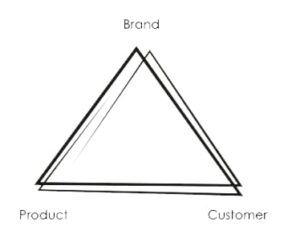

The triangle model above is a simple but useful tool for thinking through positioning. In looking at it, pretty much any marketer would say that they pay attention to all points of it to some extent. But usually, a brand’s position will have a specific orientation. So a small market share product obsessive brand will lean hard into their product offer – given the choice of pouring their discretionary budget into service, packaging or marketing, improving their product wins out every time. They also know their customers would approve of this, because they are product obsessives too. On the other hand, mainstream brands position themselves to prioritise customer service, ease, convenience and price – think Amazon, for example. Product quality matters to some extent, but can be traded off.
But what about brands which are just north of the midpoint? Not luxury, but certainly not mainstream either. Mass premium, aspirational brands like John Lewis, Ted Baker or Mini, for example.
North of the midpoint brands must embrace all aspects of the triangle: showing equal commitment to brand, product and customer orientation. They can’t simply lean into one aspect and over deliver here – mass premium involves being a more than competent all-rounder across all touchpoints. And customers are surprisingly alert to what instinctively does and doesn’t feel credible for these brands, and they quickly know when any one aspect of the experience is falling short.
If you’re north of the midpoint, make sure your market position pays equal attention to brand, product and customer service delivery. It all matters.
